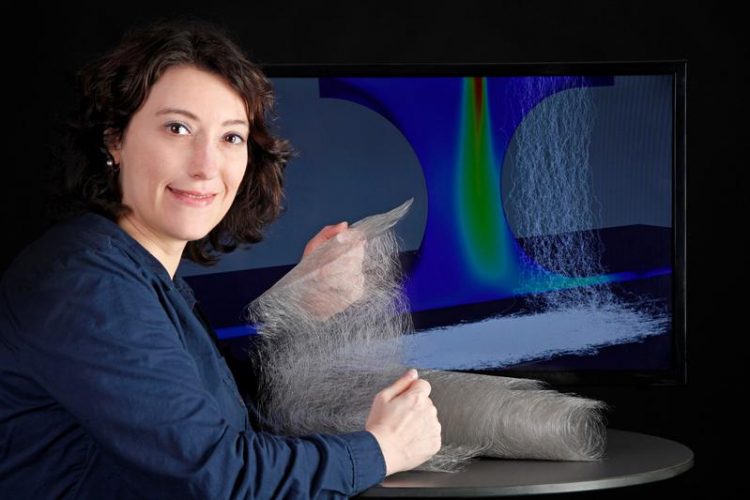High-tech in everyday life: Simulation tool for efficient production of non-woven fabrics

High-tech material non-woven: Project manager Dr. Simone Gramsch has developed the simulation tool FIDYST with her team. Fraunhofer ITWM
Non-woven materials are usually well hidden and are therefore not visible. However, if you are looking for them, you can find them everywhere: as a lining in winter jackets, as a padding in sofas, as a soundproofing mat in cars, as insulation in house walls, as a filter in kitchen exhaust hoods, as a cosmetic pad in bathrooms or as a separating layer in electric cables.
Highly absorbent non-woven can even be found in the diapers of our little children. It is an extremely versatile and high-performance material which is indispensable in our everyday lives. Accordingly, textile manufacturers and mechanical engineers are interested in keeping its production as efficient and flexible as possible.
The Fraunhofer Institute for Industrial Mathematics ITWM in Kaiserslautern has developed special software called the FIDYST tool (Fiber Dynamics Simulation Tool). It simulates the movement of fibers in turbulent air flows. In the production of non-woven materials, the fibers or threads are each stretched with the aid of air and deposited onto a conveyor belt.
Depending on the speed and temperature of the air stream, a non-woven product with the desired structure, density and strength results. One widely used application is random web, in which the individual fibers display a diverse orientation, thereby forming a random web which is simultaneously voluminous and firm.
How precisely the fibers move in the airflow and in which orientation they land on the conveyor belt is computed by the simulation software FIDYST which the researchers have developed. After simulating the airflow, the user only has to enter the material properties of the fibers in the software.
The software then simulates the dynamic behavior of thousands of fibers. Even fiber mixtures can be simulated with the software. The result can be visualized in a three-dimensional representation.
Equipped with this data, the manufacturer can then, for example, improve the air flow in a targeted manner. This results in a non-woven fabric with the desired specification while at the same time reducing energy and raw material consumption. The software simulation can calculate that by changing the configuration of the machine, fewer fibers are needed to produce a non-woven fabric with the desired structure and strength.
The Fraunhofer tool not only benefits the textile manufacturers who want to precisely configure their machines for every desired non-woven product. “Mechanical engineers can also use it to create machines that are as efficient and flexible as possible,” explains Dr. Simone Gramsch, FIDYST Project Manager at ITWM.
Despite the complex computing operations, FIDYST does not rely on expensive, high-performance computers or data centers; the tool is content with standard PCs of the upper performance class and runs on both Windows and Linux.
Unique feature of Fraunhofer
After the calculation, the data can be exported in the “EnSight Gold Case” format and then visualized and analyzed. The format is standard in applications that deal with the visualization and analysis of flow dynamics of all kinds, such as in aircraft or automotive engineering, but also in sports or medicine.
Behind FIDYST is a real world premier. For the first time, it has been possible to precisely simulate and predict fiber dynamics in air currents. “The development is the result of several years of research as well as a few doctoral theses. It has been worth it, though; with FIDYST, we have a unique feature,” says project manager Simone Gramsch.
The ITWM licenses the software to mechanical engineers or textile manufacturers. “If necessary, we also offer FIDYST as a service; then, all the simulations are executed on our computers according to the specifications of the customer,” says Gramsch. This is useful when it comes to particularly complex and, therefore, computer-intensive projects.
Mathematics lovers might be interested in the topic for another reason. More than 100 years ago, the French mathematicians Eugène and François Cosserat worked on equations to describe the behavior of elastic materials. The theory of Cosserat-Rods, named after them, ultimately formed the basis for the Fraunhofer researchers.
The Fraunhofer researchers will present a demo of FIDYST at the INDEX non-woven trade fair in Geneva (April 4 – 7, 2017).
https://www.fraunhofer.de/en/press/research-news/2017/march/simulation-tool-for-…
Media Contact
All latest news from the category: Trade Fair News
Newest articles

Decoding Cancer: 40 Years of Breakthroughs in Genetic Research
Cancer in children and adolescents is rare. Nevertheless, malignant diseases are still one of the most common causes of death in this age group. Survivors of childhood or adolescent cancer…

Let’s Think Before the First Drink: How Early Substance Use Might Lead to Brain Structure Differences Among Adolescents
Many differences appeared to exist prior to any substance use, pointing to the role brain structure may play in substance use risk, NIH-supported study suggests. Studies reveal factors that expose…

Combating Kidney Cancer Using Enhanced Immunotherapies
Medical University of South Carolina Hollings Cancer Center researcher receives Department of Defense Early Career Scholar Award to improve immune therapies by targeting resistant kidney tumors. A Medical University of…



